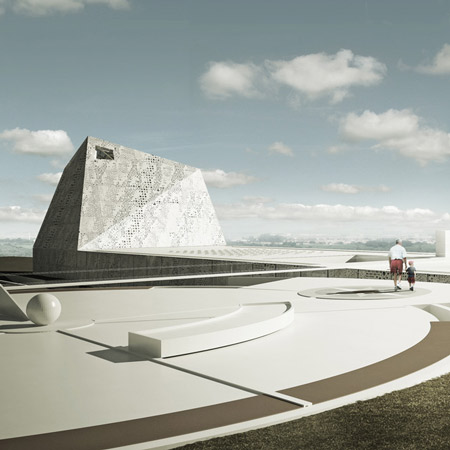
Exploratory Science Museum by CHN Arquitetos
Sao Paulo practice CHN Arquitetos have won a competition to design a new science museum in Campinas, Brazil.

Called Exploratory Science Museum, part of the State University of Campinas, their proposal beat over 100 other entries in the international public competition.
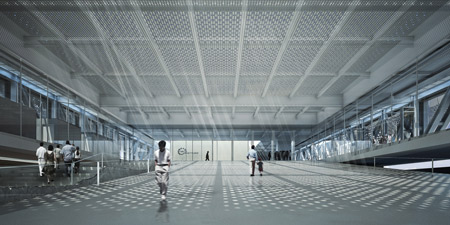
Asked to incorporate the site’s existing buildings, the architects have conceived a large rectangular structure clad in perforated aluminium plates.
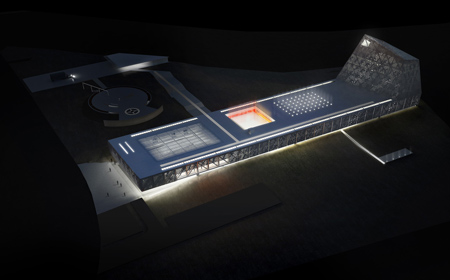
The geometric holes are designed to diffuse light and control the internal climate.
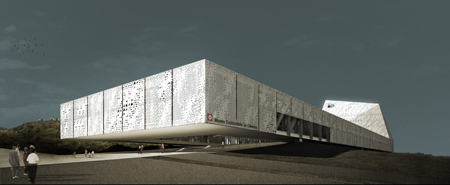
A ramp under the large structural cantilever leads to the entrance.
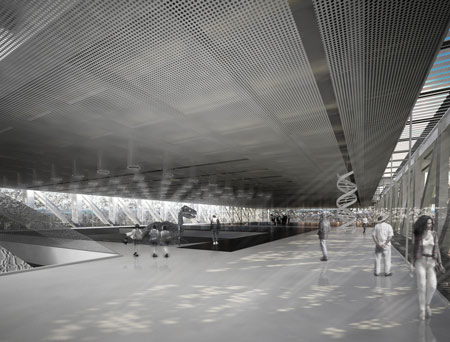
The main level comprises a shop, library, café, observatory and temporary and permanent exhibition spaces, while the lower level holds the multimedia exhibition, auditorium and science ateliers.
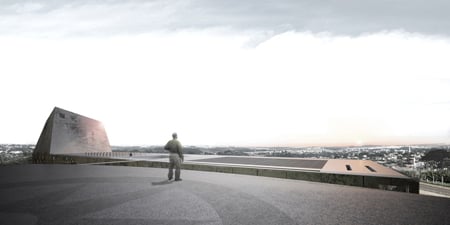
The building will be constructed of largely reflective materials, including glass, steel and aluminium.
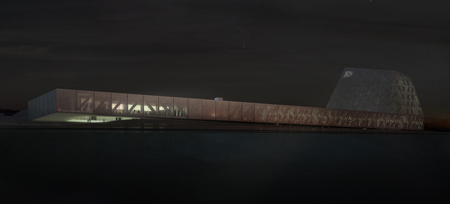
Here's some more information from CHN Arquitetos:
--
Being Science the institution and main purpose of this project it becomes possible to reveal in an exceptional manner the relation between Man and Nature. And if in that relation science is concerned with understanding the existing, architecture deals with what still does not exist: it presents itself as an opportunity of expression of Man and his creation, originating a phenomenon of its own. Upon this, two absolute conditions are presented: the singular location where the project will be placed and the universal institution to be manifested.
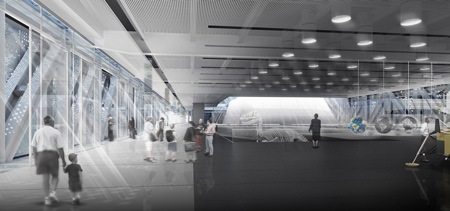
A museum as a phenomenon, a phenomenon as landscape.
First, the place reveals us the indispensable need for the relationship between the new museum and the landscape to give rise to an event of territorial scale. The new museum should become a landmark on the horizon as a geographical fact. A museum that observes and is observed. A building that reveals itself and originates a new relation between Man and Nature, Architecture and Landscape.

Second, it is crucial that the new museum should, above all, enhance the value of the institution through its architecture, be the Science in itself. The new building should reveal this aspect, be unique and not just a common structure.
Simultaneously the new building seeks through its design, the primal metaphor between the infinite dimension of the universe and the human property of understanding reality through Science: intervention and landscape, vertical and horizontal, interior and exterior, light and shadow, cosmos and individual. Architecture as a determined act of human manifestation, a scientific instrument of learning and identity for the revelation of Science. Thus, it is unquestionable and determining the synthesis of the significance of the museum and its action in the territory.
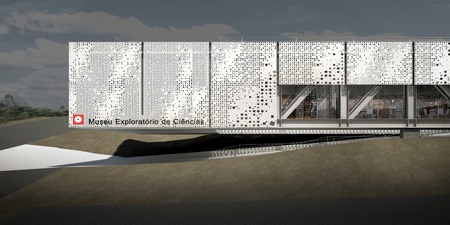
SCHEME / MASTERPLAN
The project for the Museum of Science has in its essence the possibility of allowing a multitude of impressions and comprehensions from numerous scales and distances. The relation between the users and the new museum takes place through a process of progressively discovery and knowledge. It is this experience that generates a continuous and inseparable relationship between exterior and interior.
Since the beginning the sensations and impressions caused should be able to lead a stimulated visitor inside the museum, seeking to turn his intuition in understanding.
The experience of the exterior of the building should lead to a sequence of what was apprehended outside and lead to an interior even more inspiring, keeping the visitor always connected to the experience that brought him there.
The masterplan strategy seeks the predominance of the landscape to which the museum adds itself to, contemplating three different scales: the surroundings, the campus and the user. The project configures itself as a north-south axis horizontal volume that accommodates itself in the topography and which highest level coincides with the existing square level, keeping intact and unleashing the seizure of the panoramic view in all its extension; this same volume becomes vertical and ends up marking the place, inaugurating a new event in the current context of the Campus of UNICAMP and the Metropolitan Region of Campinas, visible in an extensive range formed by cities, roads and equipments. However, only by the knowledge of its internal space is that the relationship between horizontal and vertical element is fully known and understood.
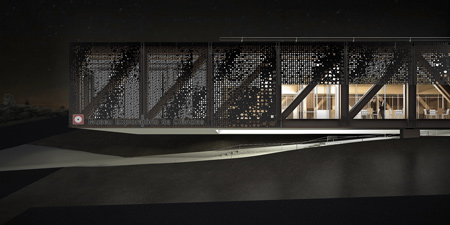
The new museum is contained in a single band where the program is distributed in different spaces and moments. The arrival happens through a large structural cantilever that leads visitors to the entrance square/ramp for reception and group accommodation before the main entrance to the museum: a place characterized by multiple uses and the capacity to accommodate a large number of users, by its configuration and dimensions.
From the external and internal reception areas, public accesses are configured in two levels. On the main level, which keeps the user always visually in contact with the outside, are all uses of open access (Shop, Library, Sunset Coffee and Observatory) and, after the controlling of paid area, the Temporary and Permanent Exhibition spaces. By this level the new museum also connects to the existing buildings that are part of the requested program. On the lower level is reached the Multimedia Exhibition, Auditorium and Science Ateliers. In the southern part of the site is located in the technical access directly connected to the Receiving and Storage docks, as well as controlled technical access to exhibition rooms.
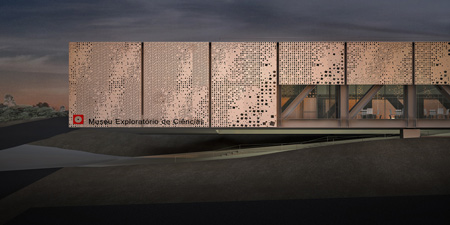
Each of the spaces and activities of the program is endowed with characteristics that identify them. Multimedia Exhibition, prepared to house NanoAventura, is configured as a volume that perforates the museum and makes itself present throughout the whole internal circulation. Furthermore, it is accessed by a path that refers to the museum's connection to the land, while the Observatory, located at the top of the vertical volume, refers directly to the Space dimension. The existing buildings (Space-Time Square and Oficina-Desafio) are incorporated through its uses and connections to the reception area of the new building, forming an upper level museology open space.
The future expansions will be located in volumes in the western portion of the site in a lower level, not interfering in the main volumes, and able to be accessed separately. The management of open spaces is done by limiting controls areas of activities that can be opened independently: the top level and lower level at the Museum, Oficina- Desafio and outdoor areas, always ensuring the complete safety of the building.
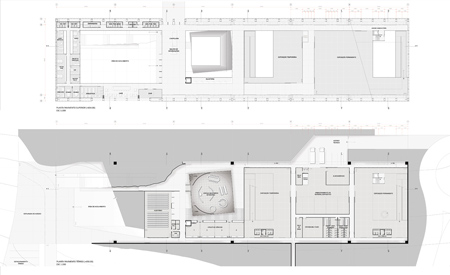
MUSEOLOGY / CIRCULATION
The museum building is offered as a powerful teaching experience of the institution, seeking the essential interaction between architecture and museology content: a synthesis of both, the museum is a building and should expose itself as such, just like science takes the knowledge through experience of reality. The freedom of the various possible displacements provides a diversity of spatialities and sensations, setting up a process of knowledge construction through the emotions that the visitor is experiencing along his movement through space. Teaching through the architecture of the museum and transforming it as a teaching tool, making it a fundamental stimulus for the visitor to ask himself about the world.
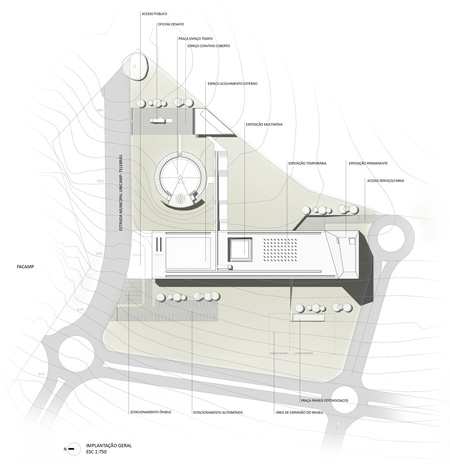
A 'scientific' itinerary concept design begins even before the arrival at the Museum when, from the first contact with the building in the site, a reading (a priori) occurs through the sensations caused by its external characteristics, stimulating questions and queries about its nature and becoming a partial understanding as you approach the building. Secondly, the route through the Museum´s interior is revealed as a clarification and understanding (knowledge) of what had been observed before. A path of progressive and singular emotions capable of stimulating the perception of the user as it experiences and interacts with the Museum. Discovering the nature and form of the building by the transition between inner and outer space of the entrance square, the access to the horizontal volume of the museum is involved by the controlled and dynamic lighting of the closures, the immersive space of the temporary exhibition and culminating in the monumental vertical space dedicated to the permanent exhibition, the visitor turns out to have a total learning of the Museum.
Finally, the moment of departure sets the last observation (a posteriori) about the institution: a different view of the outside from a distinct and cognitive repertory, now endowed with a real knowledge about the object and able to provide a definitive vision of your visit considering that this will be different for each new occasion. As Science itself, a journey that is defined by moments of search and instants of intense discovery.
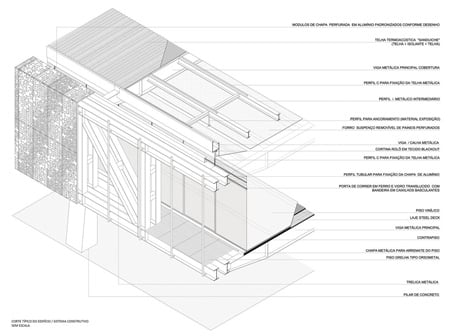
SUSTAINABILITY / ENVIRONMENTAL COMFORT
Energetic Efficiency: the comfort conditions for the users are guaranteed by natural climatization during most of the time by the fact that the building in its whole can be controlled manually, saving energy for both ventilation (air-conditioning used only when necessary to compensate external conditions or circumstances for specific exhibitions) as well as for lighting. The project will also reduce interference on the ground and enables the occupation of the rest of the area with small or large vegetation.
Facade: the aluminum plates that enclose the building functioning as brises, play a crucial thermal protection in the climatic conditions to which is exposed the museum.
The surfaces are the key elements that ensure an appropriate level of comfort within the building and the flexibility of control in the winter and summer. The predominance of the color white in almost all exterior contributes to the thermal performance to reflect the maximum of radiation effect and thus the transmission of heat into the building.

LANGUAGE / MATERIALITY
Through its masterplan design and form, combined to the matter of which is constituted, the museum brings together Science and spatial and sensory expressions. Using predominantly reflective materials (steel, aluminum and glass) the building becomes, first, a point of light, a reflection not very definite by distance, but that reveals itself as approached. A diffuse glow that refers to an event in perpetual motion as the light of day and night changes. The potentialization of a phenomenon and a stimulus for any person to ask about the world that surrounds you.
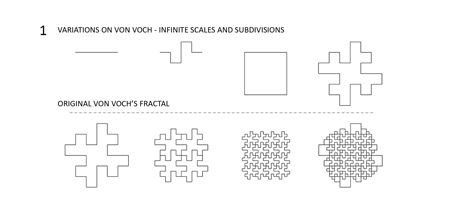
The surface of the facade is created from the idea of infinity: a reference to the essence of its form, recognizable from its cosmological scale to its most minimal. We can find similarities in everything that constitutes the universe around us and the building seeks to transmit them. Likewise, being a Science Museum, the aprehention of this information also occurs in a progressive way, from its conception to its understanding.
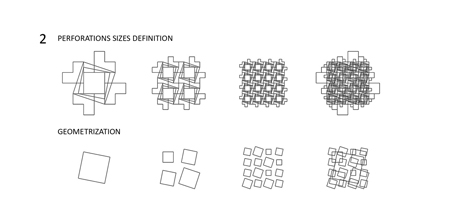
We start with a scientific knowledge of man over nature: the infinite in nature is recognized and subsequently parameterized by man through mathematical and geometric concepts. This scientific knowledge leads to a second type of infinity, synthesized in the concept of fractal: infinitesimal rate created by man from his interpretation of the characteristics of the environment that surrounds him, new notions of self-similarity and infinite complexity, capable to understand the nature and its unlimited scales. Our design is a third view over this concept creating a human interpretation of a natural event through the materiality and texture of the building.
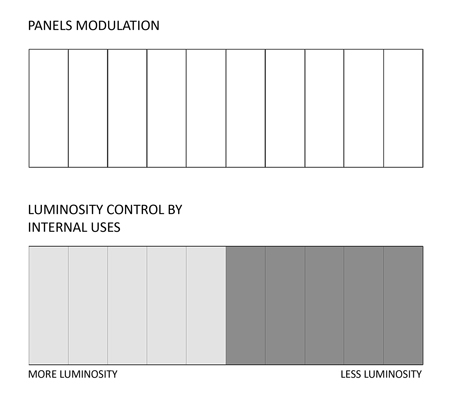
From an initial mathematical scheme a perforating "code" is drawn and applied to the surfaces. Then a pattern of 10 pieces is created, following industrial dimensions and varying its design of aperture / transparency in accordance to the quantity / size of the perforations adopted. The layout of these pieces on the facades of the building corresponds to the internal uses, being more dense or diffuse according to the luminance control required for the activities. The repetition and mixture of these pieces is capable of generating an infinite and parameterized design that will be recognized in the extent that the user observes the building from the most distant points to the interior ones, discovering it at each moment.
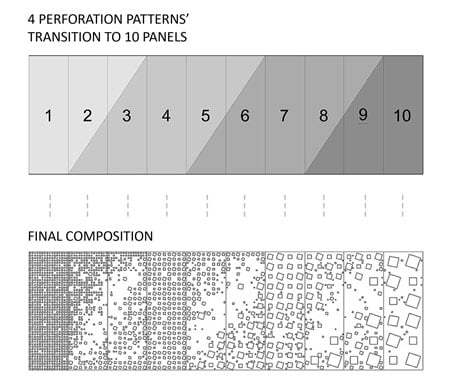
To make that the matter which constitutes the Museum may reveal the totality of its existence and turns out to have a proper meaning through human language. An event that synthesizes in itself form and function: symbol, design, climatic shield, phenomenon, didactic element, parameter of the infinite. A Museum capable of stimulating the imagination and knowledge of the individual, allowing each one to create your own story from an experience, and keep in your consciousness the magnificent relation between Man, Nature and Science.
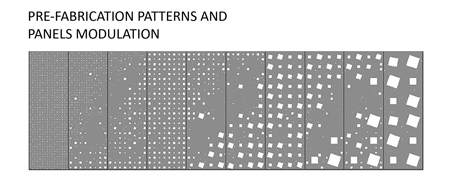
PROJECT DATA
Project Name: Exploratory Science Museum of Unicamp (First Prize - International Public Competition)
Location: Campinas, São Paulo, Brazil
Year: 2009
Site Area: 28.968m²
Construction Area: 5.370m²
PROJECT TEAM
Authors:
Daniel Corsi
Dani Hirano
Reinaldo Nishimura
Colaborators:
André Biselli Sauaia
Laura Paes Barreto Pardo
Team:
Andrea Key Abe, Jenniffer A. dos Reis, Lidia Neves Martello, Amanda Nascimento Higuti, Tatiana Hummel
Consultants:
Mônica Marcondes, Boris Villen, Bruno Sinopoli, Inês Coutinho, Ricardo Zulques, Eduardo Knothe, Raul José de Almeida, Ilan Gotlieb
Model:
Leon Richard Benkler